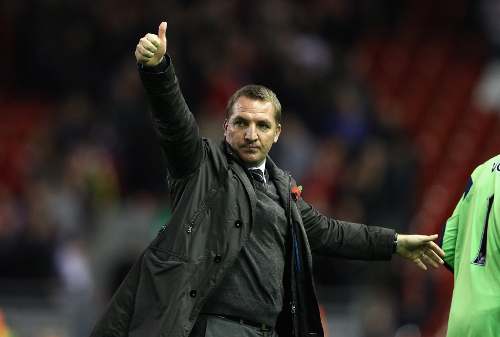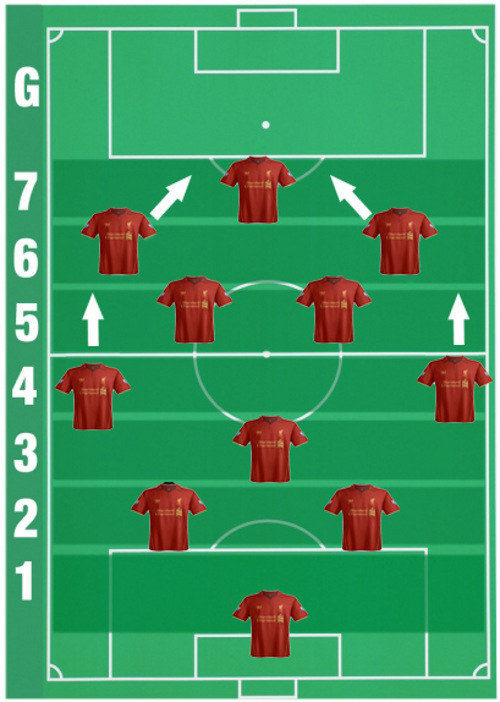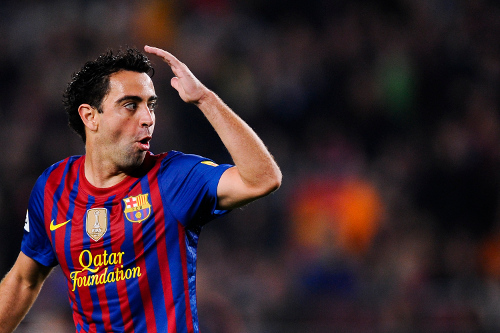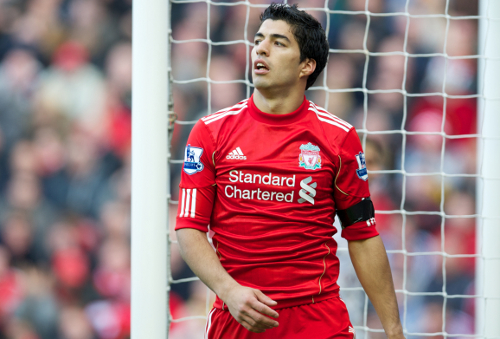Rodgers and 'Tiki Taka' - part two
Football coach and blogger Jed Davies examines the 'Tiki-Taka' philosophy deployed by Brendan Rodgers during his time at Swansea and looks at how the Ulsterman might try to implement these ideas at Anfield...
Brendan Rodgers is a man who has an appreciation of footballing perception and culture, regardless of its roots. He is a man who strives for perfection in the evolution of the game. The strategies of 'Tiki-Taka' and 'totaal-voetbal' form the basis of Brendan Rodgers' modus operandi.
For Rodgers, the season of 2011-12 will be regarded as the touchstone for 2012-13. This time however, he'll be upgrading the apparatus with which he conducts his orchestra. This article aims to reveal the 'magic' ingredients Brendan Rodgers prepared his Swansea class of 2011-12 with.

Rodgers, like Jose Mourinho, is a footballing scholar and, to further the similarity, he also employs a strict strategy in his approach to the game. However, that's where the similarities come to an end, aside from the fact they were both born on the 26th of January! Each represents alternative ends of the spectrum in footballing theory:
"I like to control games. I like to be responsible for our own destiny. If you are better than your opponent with the ball you have a 79 per cent chance of winning the game...for me it is quite logical. It doesn't matter how big or small you are, if you don't have the ball you can't score." (Rodgers 2012)
Maintaining possession, working the ball through various channels and quality of goal-scoring opportunities (rather than quantity) are apropos of the 'Tiki-Taka' school of football. To achieve success implementing 'Tiki-Taka' football, not only are a particular set of players required but a template to enable the ever-flowing movement advocated by Spain, Barcelona and Swansea:
"My template for everything is organisation. With the ball you have to know the movement patterns, the rotation, the fluidity and positioning of the team. Then there's our defensive organisation...so if it is not going well we have a default mechanism which makes us hard to beat and we can pass our way into the game again. Rest with the ball. Then we'll build again." (Rodgers 2012)
For Liverpool, a new set of fundamentals will need to be put into place; a move away from the over-reliance on direct football that maximises the quantity of goal-scoring opportunities rather than quality. A degree of trust will need to be installed in the individual's know-how about when to shoot or make the decision that the opportunity is only a half chance rather than a sure thing. The approach works on the principles that 'the whole is greater that then sum of its parts':
"The strength of us is the team. Leo Messi has made it very difficult for players who think they are good players. He's a real team player. He is ultimately the best player in the world and may go on to become the best ever. But he's also a team player. If you have someone like Messi doing it then I'm sure my friend Nathan Dyer can do it. It is an easy sell." (Rodgers 2012)
The Rodgers Strategy
In early 2012, Rodgers sketched out his strategy and explained his approach to the game to journalist Duncan White. First, he divided the pitch into eight zones and then plotted his formation. The division of zones suggests that each player, when in possession, should play a particular role, including the goalkeeper and two centre backs:
"When we have the football everybody's a player. The difference with us is that when we have the ball we play with 11 men, other teams play with 10 and a goalkeeper." (Rodgers 2012)
The formation moves away from the given 4-4-2, 4-3-3, 4-5-1 etc. way of thinking and towards a concept of zones within the playing field.

Zone 1: 'The sweeper goalkeeper'
This specialised zone is expected to take charge of a much larger zone in Tiki-Taka football compared to the more direct approach. The emphasis is on the goalkeeper to play with the ball at his feet and play far more short threaded passes than usual. Characteristics in this role include: good stature, efficiency with balls in the air, bravery, agility and willingness to play on the deck without fear - the 'keeper is expected to act as a pressure relief for under pressure team mates. Given that Liverpool's Reina received his education at Barcelona's La Masia it will come naturally to Reina to play the required role in Zone 1.
Zone 2: The 'libero'
The players in Zone 2 are, like the goalkeeper, expected to play a much larger role in 'keep-ball'. They too are expected to act as pressure relief to a compact midfield as a way-out option. The two centre-backs are expected to complement one another: one technically brilliant and one with a powerful physical presence (see: Puyol-Pique). The more technical of the two is to act as a playmaker for changing the pace of the game - Ashley Williams made more long ball attempts than any other outfield player during 2011-12. As a 'libero' you have the whole picture in front of you - you are in a position to say, 'let's go this way' or 'let's go that way'.

Zone 3: The 'volante de salida'
This player must be particularly good at playing his way out of trouble and yet still excellent at winning the ball back. Typical characteristics are the ability to read the game, act as an outlet for under-pressure teammates consistently and continually pass the ball under pressure:
"I get the ball, I pass, I get the ball, I pass, I get the ball, I pass." (Xavier Hernandez 2011)
Xavi's hypnotic approach to the game summarises the mindset for the player in this particular zone and, like Leon Britton, should boast a remarkably high pass completion rate.
Zone 4: The wing backs
The players in this zone will need to be prepared to work particularly hard, up and down the wing; both defensively and in more advanced positions. It is important to note that crosses will now be made from the by-line rather than from deep. Liverpool currently boasts a number of players who can fulfil this role like Glen Johnson, Martin Kelly and Jose Enrique.
Zone 5: The box to box creative midfielders
Flair, the ability to change the pace of the game within a second and an all-round technical ability are required to fulfil the roles in Zone 5. These players are expected to continually find space amongst the 'traffic' and complete the triangles in possession. The players should not constantly look to create the spectacular but are expected to simply knit the possession and keep the ball more often than not.
Zone 6: The inside forwards
Messi, Alexis Sanchez, Sinclair, Dyer all represent the highly creative, technically gifted and unpredictable type of player expected to fulfil the requirements of this zone. Luis Suarez is one player who could walk into the Barcelona model and will no doubt provide Liverpool with much of the answers in this zone.

Zone 7: The linking target man
This player is expected to be technically gifted when assessing his first touch, link up play and off ball movement. Carroll may well represent a target man, whether or not he adapts to act as a target man in this model is a question yet to be asked of him. Towards the end of the 2011-12 season, Carroll showed glimpses of being an extremely hardworking forward and may well find much success in this role. Anyone lucky enough to watch Fabio Borini will know that he was a huge loss to Swansea this past year, despite the success of Danny Graham.
Zone G (8): The goal-scoring opportunity and assist zone
This zone is a vastly important zone to understand. The quality of chances cannot be stressed enough. Liverpool has, over the past five years, been noted for creating chance after chance without scoring. The players who break into this zone should be extremely good at making the decision as to whether a goal-scoring opportunity is available or to turn back and play the ball back into the organism of Tiki-Taka. Barcelona however, highlighted the danger in over-relying on this concept; their play became slower and more predictable as the game went on against Chelsea in the Champions League 2011-12. For situations like this, maybe Steven Gerrard will recreate the brilliance he showed against Olympiakos in 2004 and West Ham in 2006. However, a balance between the Tiki-Taka patience and Gerrard's direct play will be reworked under Rodgers without a doubt. As a general rule, one goal should be scored to every nine shots.
En Assemble:
Behind the scenes the coaching team work extremely hard on not just educating the players, but analysing the strategy's success. Chris Davies, a match analyst will be following Rodgers across the border. The formation laid out sets about moving forward as a team and defending as a unit too. The team are expected, rather poetically, to move and press back and forth much like waves crashing onto shore:
"You win the ball back when there are 30 metres to their goal not 80" (Guardiola 2009)
Conclusion:
Whether or not Rodgers' methodology is a success at Liverpool is the question but Liverpool have kept no secrets in their approach to managers and directors this summer but all roads point to one single conceptual view of football - that of Barcelona and La Masia; the hope of becoming a successful club in perpetuity.
The variable of 'time' presents Liverpool with the biggest challenge. 'Tiki-Taka' football simply does not come about after one single season of change. Swansea were already a technically gifted side and good in possession long before Brendan Rodgers. Both Paulo Sousa and Roberto Martinez provided the club with the foundations. The core of the Swansea side has been with the club for many years. 'Tiki-Taka' has become the club's tradition.

Progress and longevity are the goals of Liverpool and Brendan Rodgers and it is this collaboration of ideologies that may well lead Brendan Rodgers and Liverpool back to the glory days of yesteryear.
Liverpool needs to restructure from the ground up and no man is better suited to become Liverpool's very own Pep Guardiola than Brendan Rodgers. Liverpool fans should expect the unexpected. But then again, what's new here? Liverpool were 3-0 down at the Atatürk Stadium when half time came in 2005:
"...and Milan now, playing football out of this world..."
Clive Tyldsley's voice echoed. The rest...
...tú sabes (you already know).
This piece was originally published on www.thepathismadebywalking.wordpress.com.



